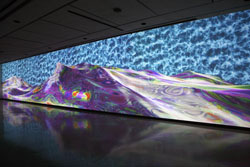

 The Wreck of the Dumaru, the centerpiece of Steinkamp’s 2004 installation at greengrassi in London, effectively reproduced many of the demands of a Pollock. Using four 3500-lumen projectors, the piece covers two entire walls, at a height of fifteen feet and combined length of seventy feet. Like many of Steinkamp’s works, The Wreck of the Dumaru is best experienced while the viewer is seated on the floor, so that the bottom of the projection corresponds with the center of one’s own sense of gravity, as its enveloping horizons discourage one from peering beyond the edge. The work, whose title references the death of the artist’s great-uncle at sea during WWI, reinforces this logic through its horizontally bisected imagery. From the ceiling line down to approximately mid-wall, one gazes upon the ocean’s surface as if flying above, its glistening blue skin inviting us to plunge deep into its cool, luminous depths. This languid image is sharply contradicted by the half of the projection directly above the floor line (the border between the two views keeps shifting), which gives us the much more aggressive vision of an angry red-green sea as it viscerally pounds its way directly at us. The patently unreal, even hallucinogenic, substance and color of the waves might be Steinkamp’s strategy for reminding us that the vivid crashing of mammoth waves at our feet is strictly a work of the imagination.
The Wreck of the Dumaru, the centerpiece of Steinkamp’s 2004 installation at greengrassi in London, effectively reproduced many of the demands of a Pollock. Using four 3500-lumen projectors, the piece covers two entire walls, at a height of fifteen feet and combined length of seventy feet. Like many of Steinkamp’s works, The Wreck of the Dumaru is best experienced while the viewer is seated on the floor, so that the bottom of the projection corresponds with the center of one’s own sense of gravity, as its enveloping horizons discourage one from peering beyond the edge. The work, whose title references the death of the artist’s great-uncle at sea during WWI, reinforces this logic through its horizontally bisected imagery. From the ceiling line down to approximately mid-wall, one gazes upon the ocean’s surface as if flying above, its glistening blue skin inviting us to plunge deep into its cool, luminous depths. This languid image is sharply contradicted by the half of the projection directly above the floor line (the border between the two views keeps shifting), which gives us the much more aggressive vision of an angry red-green sea as it viscerally pounds its way directly at us. The patently unreal, even hallucinogenic, substance and color of the waves might be Steinkamp’s strategy for reminding us that the vivid crashing of mammoth waves at our feet is strictly a work of the imagination.
Steinkamp’s overlapping of a bird’s-eye perspective with that of the earthbound mortal is a compositional device which painters of religious subjects made use of for centuries, as a means of linking man’s heavenly aspirations with the very real limits of his mortal being. An even more explicit source for The Wreck of the Dumaru, however, is Gevicault’s Raft of the Medusa, in which the perilous state of the raft’s passengers is visually dramatized by our wsea-level perspective. With its reference to the slow agonies of death at sea, Steinkamp’s narrative in The Wreck of the Dumaru might not be so different than Gevicault’s, especially when one takes into account reports that her great uncle suffered hallucinations before his death, after thirteen days in a lifeboat on the open sea with insufficient provisions. Clearly the crimson sea in The Wreck of the Dumaru is the stuff of sailors’ nightmares, the towering scope of its angry peaks matched only by its supreme indifference to the fate of any mortals in its path.